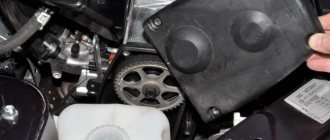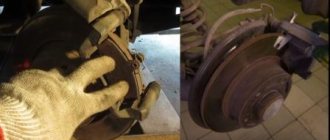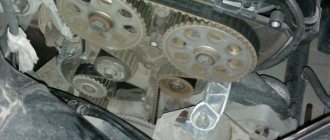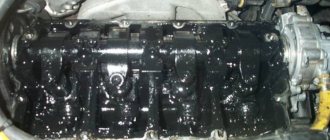The production of a domestic modification of the Lada Granta has been carried out for several years. The car has gained significant credibility due to its acceptable quality and level of performance, as well as the presence of several different configuration versions.
Today we’ll figure out when to change the timing belt, as well as which timing belt is better.
Causes of timing belt wear
The main reason why it is necessary to regularly replace the belt is natural wear. During vehicle operation, the belt moves at high speed along metal rollers, pulleys and guides, being under high tension.
At the same time, the belt is subjected to additional loads, which significantly increase wear:
- high temperature changes in the engine compartment (up to 100 degrees in winter);
- beating in case of wear of the tensioning mechanism;
- short-term loads due to internal combustion engine friction, uneven movement of valve pushers, changes in clearance values;
- liquids, contaminants and oils getting on the timing belt;
- random objects rubbing against the surface of the belt (casing, wires, fastening elements).
The cause of premature belt failure can be serious mechanical malfunctions of the engine:
- damage to the crank mechanism;
- jamming of valves and piston group;
- damage to the camshaft, rollers;
- wear of the crankshaft and camshaft guide pins.
If we take into account all the risks that arise during the operation of the belt, it is advisable to artificially reduce the resource declared by the manufacturer by 20 - 30%.
One of the reasons for premature wear: inadequate quality. Since the timing belt is an important component, you should not skimp on a dubious manufacturer and seller.
Prices and articles, originals and analogues of timing belts
In the operation of any engine, the timing belt plays a primary role, so you need to choose it very carefully. Today there are several proven manufacturers on the market, whose products are in great demand. The best timing belts for Granta are produced by the following companies:
- Contitech (mostly good quality belts, but their cost is high);
- Gates (you need to be careful with this brand - there is a high probability of fakes, in principle, as with any other brand);
- Dayco (good belts for the money);
- Bosch (probably the most famous, and also often counterfeited brand);
- BRT (Balakovorezinotekhnika, practically “Russian Gates”, at the same cost).
The length of the new timing belt for the 8-valve Grant is 823 mm. It will cost about 700 rubles, the original article number in the catalog is 1118-1041020-07.
The timing belt for the Lada Granta with a 16-valve power unit has 137 teeth and a width of 22 mm.
As for the prices of analogues, we can say that the cost of the same timing belt kit with rollers under the article number K015521XS, from the Gates brand, starts from only 1 thousand rubles. When purchasing products from a well-known company, every car owner must be careful not to fall for a fake.
Signs of critical belt wear
Signs of wear are distinguished: direct and indirect.
Direct signs of wear include:
- presence of cracks on the belt surfaces (external and internal);
- chips on the inner surfaces of the teeth;
- longitudinal sections on the outer surface;
- presence of heavy contamination;
- visible runout and stretching of the timing belt;
- extreme cases - belt breakage, “licking” of teeth.
The listed signs can be detected by visual inspection. In most cases, this requires removing the belt cover. In some car models, this requires “hanging” the engine and carrying out a series of dismantling works. Therefore, before deciding to diagnose the condition of the belt drive, it is necessary to evaluate indirect signs of wear, which include:
- misfires in engine cylinders;
- detonation, especially at the moment of shutdown;
- uneven idle speed.
These signs can be examined using computer diagnostics. The most effective diagnostic result is achieved by studying the ignition angle in dynamic mode (with the engine running). Typically it should be within plus or minus five degrees. In this case, the ignition timing when the engine rotates at idle speed should not change significantly.
What are the signs of a worn belt?
The indicated factors will allow you to accurately determine the moment when damage begins to appear on the Lada Granta belt, which will prevent its unexpected failure (break). When to change the timing belt, how can you tell if it is worn out?
- Primary signs include a significant degree of material wear. This fact can easily provoke the “consumables” to slip or break when the load on the engine is insignificant or in conditions of high atmospheric humidity.
- The appearance of wear is often caused by a violation of the correct position of the roller in relation to the pulley. This can be confirmed by increased heating of the bearing and fabric remnants of worn out cords sticking out to the sides, used to reinforce the rubber base of the belt.
- The next sign will be the presence of cracks and peeling. The greater the number of these defects, the higher the chance of an early belt break.
- If the back surface appears excessively hard, it can be revealed by the presence of shine. This factor, associated with loss of elasticity, indicates a loss of sufficient contact between the belt and the pulleys.
- During operation, the belt surface may lengthen, which can cause it to jump on the teeth of the shaft pulley. Replacing the belt in this case is straightforward.
- Failure of the roller is a direct evidence of incorrect positioning of the belt in relation to its working plane.
Timing for replacing timing belts
When the question is raised about the frequency of belt replacement, first of all, we mean the maximum period during which the belt retains its properties. At the same time, the probability of its stretching and breaking, which can lead to serious damage, is calculated.
There are special programs (AUTODATA, ELSA and others) that clearly establish the timing of routine maintenance, including the replacement of belts and rollers. However, these programs do not take into account the operating conditions of the car and available components. Ordinary drivers and most non-dealer service stations are guided by the established operating life and mileage of the car. It's better to judge by mileage. Many people estimate the period for mandatory belt replacement based on mileage to range from 50,000 to 80,000. However, if the car is used little, its annual mileage is, for example, 5,000 per year, this does not mean that the belt must be replaced every 10 years. The maximum service life of a car without replacing the timing belt is usually 5 - 7 years (subject to mileage conditions).
It is also necessary to take into account the characteristics of the engines. If the engine has two camshafts, there are more valves, and accordingly, greater loads are placed on the belt.
At the same time, the tension roller (or mechanism) and guides should be changed along with the timing belt. In most cases, adjustment of the ignition angle is required. Modern engine control systems block engine starting if the ignition angle is incorrect. This is done to ensure that when setting the wrong angle, accidental starting and destruction of the timing system does not occur.
When determining the timing of belt replacement, it is necessary to take into account operating conditions and vehicle mileage. If the machine is operated in conditions of extremely low or high ambient temperatures, the replacement period must be reduced by 10 - 15%.
In order to reduce the likelihood of abnormal timing belt damage, you should:
- monitor the integrity of the protective casing;
- do not allow foreign liquids, oils, or objects to get into the belt area;
- observe the frequency of routine maintenance.
Technical regulations of the AvtoVAZ plant for belt replacement
Cars of the Lada Granta family are equipped, as we have already said, with various engine modifications. Some of them do not have the problem that when the timing belt breaks, the valves bend, while others have a similar feature.
Only the 11183-50 engine does not bend the valve if the timing belt breaks; this engine is installed on the Lada Granta in the standard configuration. Read more about in which engines, when the timing belt breaks, the valves tear in this material.
To eliminate the occurrence of an emergency situation, the manufacturer recommends changing the belt once every seventy-five thousand kilometers . But you will have to monitor its condition more often - during each maintenance, that is, after 15 thousand kilometers. This statement is true for both 8-valve and 16-valve engines. Even though the most common Lada Granta engine, model 21116, is equipped with an imported cylinder head, it will also have to undergo expensive repairs as a result of a broken belt!
Naturally, the manufacturer does not recommend replacing the belt yourself, as well as checking it. If you try to do all the work yourself, there is a high probability that you will be denied subsequent warranty service. It is recommended to change only the filter yourself (replacing the cabin filter, replacing the air filter, replacing the fuel filter).
general information
Most often, the timing mechanism is located in the front of the car; in older car models it can be found between the engine cylinder and the radiator. Today, manufacturers are trying to reliably hide the part, however, to find it, you just need to unscrew the protection and start repairing. The composition of the element is a rubber mixture. Many manufacturers use highly saturated nitrile, which provides excellent wear resistance at high temperatures. There are teeth on the inside. Manufacturers produce their own type of belts for each car model.
A broken belt will cause many problems for your car. The whole point is that the part uses basic systems. When it breaks, the shaft freezes in one position. The pistons continue to move, hitting the valves and deforming them. The consequences can be dire.
The main reasons for the break:
- An unscrupulously assembled car engine.
- Severely worn mechanism.
- The elasticity of the material has deteriorated significantly - rupture occurs.
- Poor quality workmanship of the part.
- Pump rollers are not tensioned well.
Advice from Lada Granta owners
Most Lada Granta owners, especially owners of 16-valve engines (repairs are much more expensive than an 8-valve equivalent), are advised not to wait until the required 75 thousand kilometers. The fact is that low-quality components can lead to wear and tear starting after 20 thousand kilometers.
Most owners use well-proven Gates products when replacing. But they like to fake this brand, so try to buy from time-tested suppliers!
K015670XS - spare part article for 16-valve engines.
K015670XS
A couple of tips on replacing the timing belt
If you decide to replace the belt yourself, then you should consider some recommendations.
For example, after installing the belt, you will also need to tension it correctly. This is done using a special key. Some will note that you can get by with improvised means, but then no one guarantees the result.
The force, which is typical for turning the belt 90 degrees between the crankshaft and camshaft pulleys, should not be more than 20 Nm, but it should not be allowed to be below 15 Nm. All other indicators will tell you that the belt tension was incorrect and further adjustment will be required.
Replacement frequency
The timing life is on average 60–80 thousand kilometers. But there are cases when belts run both 150,000 km and 30 thousand km. For each vehicle, the resource is determined in the manufacturer’s service data. We recommend focusing on this information.
But also remember that difficult operating conditions of the car significantly reduce the timing life. In fact, if the vehicle is driven on bad roads, the value of the numbers decreases. The fact is that manufacturers test cars at testing grounds, and if you drive through city traffic jams every day, the mechanism of the car has a more negative impact. Among other things, bad weather conditions also affect the service life.
The degree of wear of the gas distribution mechanism is most influenced by the mileage of the vehicle. Different car models have their own meaning. Rapid wear of a part can be associated with bad roads, mud, and frequent city traffic jams. Manufacturers recommend changing the element after 50–60 thousand kilometers. Often car owners also change the rollers. The fact is that if the roller stops (jams), then the new part will become unusable. Problems may also arise with other vehicle mechanisms.
Factory regulations for timing of timing belt replacement
Each vehicle manufacturer specifies the timing of maintenance and other routine maintenance. According to this document, replacing the timing belt on a Lada Granta car should be done when the car has driven no more than 75 thousand km . In fact, this figure does not always correspond to reality; there are a number of reasons for this. The service life of a timing belt will depend on:
Much attention is paid to the manufacturing quality of rubber products, but the quality of parts from different manufacturers varies greatly. The main supplier for VAZ is the RTI plant, which is located in Balakovo. In addition to it, engines can be equipped with products from other companies such as Gates, ContiTech, Trialli, Bosch, and some others. You should carefully consider the product you are purchasing, since you can buy a fake under the guise of products from well-known manufacturers.
The operating conditions of the vehicle, especially its engine, also affect the service life of the timing drive. In 16 valve modifications, the load on the belt teeth increases, so it requires more attention. Fuel and technical fluids are not allowed to enter the operating area of the timing mechanism drive. They soften the body of rubber products, make the material pliable, and the teeth are easily cut off. At the slightest manifestation of leaks in the operating area of the timing drive, they must be eliminated immediately.
The teeth of the crankshaft gears and camshafts gradually wear out, and the height of the teeth decreases. This means that the contact area with the belt becomes smaller, making it easier to tear off the toothed belt comb. The coolant pump can also become a source of trouble for the timing drive. Sometimes it jams, and since the pump is rotated by a toothed belt, its teeth are cut off.
With a relatively small annual mileage of the car, you should also carefully monitor the condition of the timing mechanism parts. The belt ages even if the engine is not running, so it is inspected at every maintenance. If even small cracks are noticed, the delamination changes. The optimal time to replace the timing belt in the timing mechanism drive will be a mileage of 50–60 thousand km.
Recommendations from Lada Granta owners
You can find a lot of material on this car model on the Internet. Lada Granta owners (call themselves grant owners) talk about their cars and give recommendations on how to properly recommend a car. Drivers of 16 valve Grant recommend not to wait until the mileage is 50–60 thousand km, but to change the drive earlier. On the Grant 8 valve, if the drive in the “83” engine breaks, no damage to the valves occurs; for other modifications of the power unit, this can result in an expensive engine overhaul. You should not skimp on replacing the tension roller or coolant pump; they are the ones that most often damage the belt teeth.
Tips on how to increase resource
- Warm up the engine before driving in cold weather.
- When replacing, also change the rollers and pump, following the manufacturers' recommendations.
- Buy spare parts from trusted brands, check whether you have purchased a counterfeit.
While writing the article, I was able to find statistics on the mileage at which the belt broke on cars. The statistics are as follows:
Of course, the data is difficult to analyze, since neither the car brands nor the operating conditions are known. In general, we can conclude: check whether the timing belt on your car has reached the end of its life, replace it in proven places and do not skimp on spare parts.
VAZ cars: repair, maintenance, tuning
Replacing the timing belt on a 106-horsepower 16-valve Lada Granta 1.6 service will cost approximately $40-45. This seems like enough incentive to roll up your sleeves and replace the belt yourself. The whole job will take no more than an hour and a half and does not require any special skills.
Reviews
I changed the belt at 100 thousand km, leaving the old rollers. As a result, 130 thousand km. The bearings fell apart and the belt broke.
The timing belt was changed at 80 thousand km, the condition was acceptable. But I drive on harsh roads and, in order to avoid problems with valves, etc., I decided to change them in advance. The manufacturer's regulations are 120 thousand km.
After buying the car, the first factory belt was changed after 61 thousand km, it was changed by the officials. I asked them to show me the old belt and didn't notice any wear on it at all.
What are the expected consequences of a break?
As stated, no problems with the Lada Granta engine in the 8-valve version, or if the belt drive breaks, arise only in the version of the “11183-50” unit. The remaining engines are at risk of failure in the event of a designated unpleasant incident. In view of this, a dispute arose among the “Grantavods” regarding the advantages of LADA Granta engines with 16 and 8 valves, and which unit has more of them. Your point of view will also be very interesting.
If the belt drive breaks, the camshaft stops in the position corresponding directly to the moment of failure. In contrast, the crankshaft is subject to continued rotation. This causes the pistons to hit the valves that were in the open position at a given moment. Then the latter bend, but sometimes a breakdown of the piston bottom occurs. Popularly called “fist of friendship”!
It is based on this fact that experts are inclined to recommend changing the timing kit before the period stated by the manufacturer for this action.
Replacing the belt on an 8-valve Lada Granta engine. Detailed description
After making sure that the part is in poor condition, you need to prepare for the procedure of replacing the timing belt on a Lada Granta 8 valve. First of all, you need to provide a comfortable place to work, well lit, spacious enough and safe.
Tools you will need:
The tensioner pulley is often replaced at the same time, so it is necessary to purchase it in advance. In all stores you can buy a timing belt pulley for Granta as a set.
Before starting work, you must unscrew the ground wire from the battery.
Let's consider the process of replacing the timing belt on a Lada Granta car using the example of an 8-valve engine. Main stages of work:
Preparing for repairs. The car is jacked up and the front wheel is removed from the right side, as well as the protection that blocks access to the engine.
Removing the protective cover. On Grant cars, the plastic cover consists of two parts. It's easy to remove. First you need to unscrew the 4 bolts of the upper part, and then the lower part.
To do this, you need to use a 5-point hex key. In addition to the cover, you also need to remove the crankshaft position sensor by simply disconnecting it from the connector and removing it from the socket.
Alignment of marks. Before replacing the timing belt on Granta 16 and 8 valves, it is necessary to correctly set the engine valve timing. To do this, you need to turn the crankshaft clockwise. This is done using a 17-inch socket. You need to turn it until the mark on the camshaft toothed pulley coincides with the mark on the inner surface of the timing cover.
In addition, the marks must line up on the engine flywheel. This can be checked through a special hatch in the upper part of the clutch housing. After removing the rubber plug, you need to make sure that the special protrusion on the flywheel coincides with the camshaft mark.
Only after this can you continue replacing the timing belt on the Lada Granta.
Removing the generator pulley. To prevent the shafts aligned to the marks from turning, the flywheel can be locked through the inspection hatch. The most convenient way to do this is with a thick screwdriver or pry bar. Having firmly secured the flywheel, carefully unscrew the nut holding the generator pulley and remove it along with the washer.
Next, loosen the generator pulley nut
Adjusting the tension roller. Using a 15mm wrench, you need to gradually loosen the tightening of the roller mounting bolt. When the fastening is loosened enough to allow sagging, you can begin dismantling, making sure once again that all the marks match.
Withdrawal. The part is carefully removed from all pulleys and removed from the engine compartment. If there is a complete break in the timing belt on Grant's car, this is even easier to do.
Helpful advice: while you are changing the timing belt on the Grant, the protective cover is removed and you can check the condition of the water pump and tensioner pulley. The video is removed and played in the hands. If there is no extraneous noise and the bearing does not jam, it is installed back. The water pump is checked by twisting it by the pulley. If nothing sticks, she's fine.
Installation of a new spare part.
Before use, the timing belt on Grant 8 valves is checked for manufacturing defects - peeling, cracks, excessive roughness of the material. It would be useful to look at the expiration date, since rubber loses its properties even without being used, but after lying on the shelf for several years. The number of teeth on the Lada Granta belt with an 8-valve engine is 113, and its width is 17 mm. Installation of the part is carried out in the reverse order. First, it is pulled onto the crankshaft, then onto the generator and pump, circling the roller, and at the very end - onto the camshaft. Tension. To ensure good tension, you need to rotate the roller counterclockwise. This is done using a special key, which consists of 2 metal rods. These are inserted into the corresponding holes on the roller and the roller is rotated until the cutout on the roller cage aligns with the rectangular mark on the inner sleeve. Only after this can the roller bolt be tightened.
In order to understand the sequence of work, we present to your attention an explanatory video about where to look for tags:










